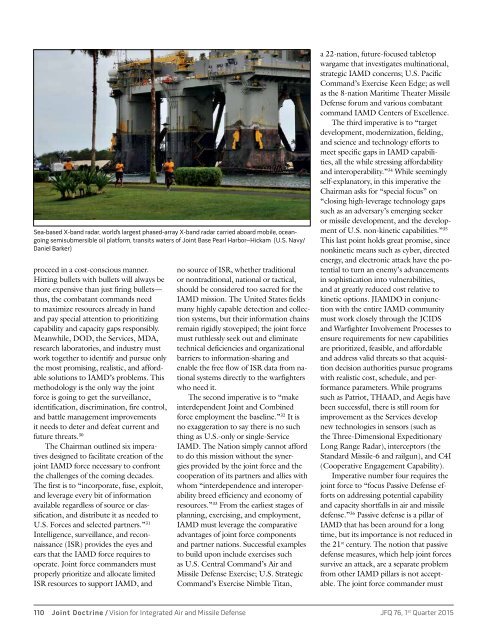jfq-76
jfq-76
jfq-76
Create successful ePaper yourself
Turn your PDF publications into a flip-book with our unique Google optimized e-Paper software.
Sea-based X-band radar, world’s largest phased-array X-band radar carried aboard mobile, oceangoing<br />
semisubmersible oil platform, transits waters of Joint Base Pearl Harbor–Hickam (U.S. Navy/<br />
Daniel Barker)<br />
proceed in a cost-conscious manner.<br />
Hitting bullets with bullets will always be<br />
more expensive than just firing bullets—<br />
thus, the combatant commands need<br />
to maximize resources already in hand<br />
and pay special attention to prioritizing<br />
capability and capacity gaps responsibly.<br />
Meanwhile, DOD, the Services, MDA,<br />
research laboratories, and industry must<br />
work together to identify and pursue only<br />
the most promising, realistic, and affordable<br />
solutions to IAMD’s problems. This<br />
methodology is the only way the joint<br />
force is going to get the surveillance,<br />
identification, discrimination, fire control,<br />
and battle management improvements<br />
it needs to deter and defeat current and<br />
future threats. 30<br />
The Chairman outlined six imperatives<br />
designed to facilitate creation of the<br />
joint IAMD force necessary to confront<br />
the challenges of the coming decades.<br />
The first is to “incorporate, fuse, exploit,<br />
and leverage every bit of information<br />
available regardless of source or classification,<br />
and distribute it as needed to<br />
U.S. Forces and selected partners.” 31<br />
Intelligence, surveillance, and reconnaissance<br />
(ISR) provides the eyes and<br />
ears that the IAMD force requires to<br />
operate. Joint force commanders must<br />
properly prioritize and allocate limited<br />
ISR resources to support IAMD, and<br />
no source of ISR, whether traditional<br />
or nontraditional, national or tactical,<br />
should be considered too sacred for the<br />
IAMD mission. The United States fields<br />
many highly capable detection and collection<br />
systems, but their information chains<br />
remain rigidly stovepiped; the joint force<br />
must ruthlessly seek out and eliminate<br />
technical deficiencies and organizational<br />
barriers to information-sharing and<br />
enable the free flow of ISR data from national<br />
systems directly to the warfighters<br />
who need it.<br />
The second imperative is to “make<br />
interdependent Joint and Combined<br />
force employment the baseline.” 32 It is<br />
no exaggeration to say there is no such<br />
thing as U.S.-only or single-Service<br />
IAMD. The Nation simply cannot afford<br />
to do this mission without the synergies<br />
provided by the joint force and the<br />
cooperation of its partners and allies with<br />
whom “interdependence and interoperability<br />
breed efficiency and economy of<br />
resources.” 33 From the earliest stages of<br />
planning, exercising, and employment,<br />
IAMD must leverage the comparative<br />
advantages of joint force components<br />
and partner nations. Successful examples<br />
to build upon include exercises such<br />
as U.S. Central Command’s Air and<br />
Missile Defense Exercise; U.S. Strategic<br />
Command’s Exercise Nimble Titan,<br />
a 22-nation, future-focused tabletop<br />
wargame that investigates multinational,<br />
strategic IAMD concerns; U.S. Pacific<br />
Command’s Exercise Keen Edge; as well<br />
as the 8-nation Maritime Theater Missile<br />
Defense forum and various combatant<br />
command IAMD Centers of Excellence.<br />
The third imperative is to “target<br />
development, modernization, fielding,<br />
and science and technology efforts to<br />
meet specific gaps in IAMD capabilities,<br />
all the while stressing affordability<br />
and interoperability.” 34 While seemingly<br />
self-explanatory, in this imperative the<br />
Chairman asks for “special focus” on<br />
“closing high-leverage technology gaps<br />
such as an adversary’s emerging seeker<br />
or missile development, and the development<br />
of U.S. non-kinetic capabilities.” 35<br />
This last point holds great promise, since<br />
nonkinetic means such as cyber, directed<br />
energy, and electronic attack have the potential<br />
to turn an enemy’s advancements<br />
in sophistication into vulnerabilities,<br />
and at greatly reduced cost relative to<br />
kinetic options. JIAMDO in conjunction<br />
with the entire IAMD community<br />
must work closely through the JCIDS<br />
and Warfighter Involvement Processes to<br />
ensure requirements for new capabilities<br />
are prioritized, feasible, and affordable<br />
and address valid threats so that acquisition<br />
decision authorities pursue programs<br />
with realistic cost, schedule, and performance<br />
parameters. While programs<br />
such as Patriot, THAAD, and Aegis have<br />
been successful, there is still room for<br />
improvement as the Services develop<br />
new technologies in sensors (such as<br />
the Three-Dimensional Expeditionary<br />
Long Range Radar), interceptors (the<br />
Standard Missile-6 and railgun), and C4I<br />
(Cooperative Engagement Capability).<br />
Imperative number four requires the<br />
joint force to “focus Passive Defense efforts<br />
on addressing potential capability<br />
and capacity shortfalls in air and missile<br />
defense.” 36 Passive defense is a pillar of<br />
IAMD that has been around for a long<br />
time, but its importance is not reduced in<br />
the 21 st century. The notion that passive<br />
defense measures, which help joint forces<br />
survive an attack, are a separate problem<br />
from other IAMD pillars is not acceptable.<br />
The joint force commander must<br />
110 Joint Doctrine / Vision for Integrated Air and Missile Defense JFQ <strong>76</strong>, 1 st Quarter 2015




